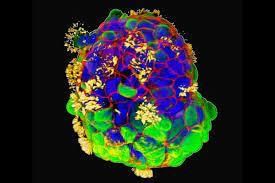Science & Technology - 6 | Current Affairs & Hindu Analysis: Daily, Weekly & Monthly - UPSC PDF Download
| Table of contents |

|
| Anthrobots |

|
| Aspex: Isro’s Aditya L1 Space Craft |

|
| Gemini |

|
| Genome Sequencing of Jamun |

|
| Dress Syndrome |

|
Anthrobots
Recently, scientists have created miniature robots utilizing human cells, referring to them as "anthrobots."
About Anthrobots
- Constructed from human tracheal cells, these bio-robots possess self-assembly capabilities.
- Capable of both movement and healing neurons within a laboratory setting, they can spontaneously fuse together to form a larger structure called a superbot, encouraging the growth of neurons.
- In terms of size, they measure between the width of a human hair and the tip of a sharpened pencil.
- The anthrobots exhibit diversity in structure and behavior, with some taking on a spherical shape fully covered in cilia, while others resemble a football shape irregularly adorned with cilia.
- These anthrobots differ from Xenobots, which are created from embryonic stem cells of frogs.
Application:
- Anthrobots hold promise for regenerative medicine, wound healing, and disease treatment.
Tracheal Cells:
- These cells are from the lining of the bronchi/trachea, the network of tubes used to convey air to the lungs.
- They are responsible for producing lubricating mucus to keep the airways functional and are a type of epithelial cell, a term used generally to refer to cells lining the inside or outside of the body.
- These cells generate mucus and various other compounds, playing a crucial role in respiration.
Aspex: Isro’s Aditya L1 Space Craft
ISRO's Aditya L1 spacecraft, launched in September for Sun exploration, has initiated the operation of its second instrument, ASPEX (Aditya Solar Wind Particle Experiment).
What is ASPEX?
ASPEX, also known as the Aditya Solar Wind Particle Experiment, is a scientific apparatus aboard ISRO’s Aditya L1 spacecraft, designed for the examination of solar wind particles. It incorporates instruments like the ‘Solar Wind Ion Spectrometer’ (SWIS) for a comprehensive analysis of charged particles (ions) from the Sun and the ‘Suprathermal and Energetic Particle Spectrometer’ (STEPS) concentrating on the study of high-energy particles emitted by the Sun. The significance of ASPEX lies in its contribution to the comprehension of space weather and its potential impact on Earth’s communication systems and power grids.
Gemini
Google has introduced its newest artificial intelligence initiative, named "Gemini," aimed at showcasing behavior that resembles that of humans.
About
- The deployment will take place gradually, introducing less advanced versions called "Nano" and "Pro" into Google's AI-driven chatbot Bard and the Pixel 8 Pro. Significant improvements are anticipated in the early months of next year with the release of the "Ultra" model, enhancing an advanced iteration of Bard.
- Google highlights Gemini's capabilities in problem-solving, particularly in math and physics, while reaffirming its dedication to addressing AI risks responsibly.
Genome Sequencing of Jamun
Scientists at the Indian Institute of Science Education and Research (IISER) Bhopal have successfully carried out the inaugural genome sequencing of the jamun tree (Syzygium cumini).
About:
- The primary objective of the study was to acquire insights into the genomic and evolutionary foundations of the medicinal properties associated with jamun.
- The research team utilized Oxford Nanopore and 10x Genomics sequencing technologies for the comprehensive sequencing of the S. cumini genome.
- The analysis brought to light an increased count of coding genes in the jamun genome, indicating a neopolyploidy event.
- The research pinpointed crucial genes involved in the adaptive evolution of jamun, contributing to its recognized anti-diabetic, antioxidant, and anti-inflammatory characteristics.
- A neopolyploidy event refers to the occurrence of polyploidy, a condition where an organism possesses multiple sets of chromosomes, leading to an augmentation in the chromosome count in its cells.
- Polyploidy can manifest through various mechanisms, including errors during cell division or hybridization between distinct species.
Dress Syndrome
Context:
The Indian Pharmacopoeia Commission (IPC) has released a drug safety advisory concerning the pain reliever Meftal, alerting about possible adverse reactions linked to mefenamic acid, including the potential risk of Drug Rash with Eosinophilia and Systemic Symptoms (DRESS) syndrome.
What is DRESS syndrome?
- DRESS syndrome is a severe and potentially life-threatening idiosyncratic reaction to specific medications.
- It is characterized by a delayed onset of symptoms, including fever, skin rash, lymphadenopathy, eosinophilia (an increase in a type of white blood cells), and various systemic manifestations.
What is Meftal?
- Meftal is commonly prescribed for conditions such as rheumatoid arthritis, osteoarthritis, dysmenorrhea, mild to moderate pain, inflammation, fever, dental pain, muscle and joint pain, period pain, sore throats, nerve pain, and muscle aches.
- Prolonged use of Meftal and similar drugs may increase the risk of stomach ulcers, bleeding, and adverse effects on the cardiovascular system.
About:
- The Indian Pharmacopoeia Commission (HQ: Ghaziabad, UP; founded: 1956) is an autonomous institution of the Ministry of Health and Family Welfare, responsible for setting standards for all drugs manufactured, sold, and consumed in India.
|
38 videos|5264 docs|1112 tests
|
FAQs on Science & Technology - 6 - Current Affairs & Hindu Analysis: Daily, Weekly & Monthly - UPSC
| 1. What is the purpose of Isro's Aditya L1 Space Craft? |  |
| 2. How does the Gemini genome sequencing technique work? |  |
| 3. What is the significance of genome sequencing of Jamun? |  |
| 4. What is Dress Syndrome? |  |
| 5. How do anthrobots contribute to science and technology? |  |
























